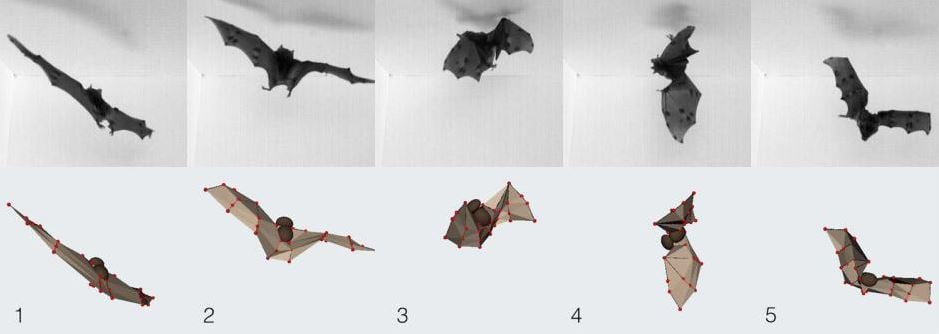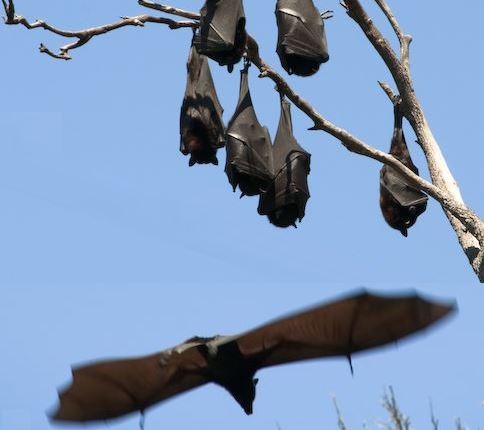Bats land upside down thanks to their comparatively beefy wings, say scientists from the School of Engineering at Brown University, Rhode Island, USA. Bats have heavy wings compared to other flying animals like insects and birds. This extra wing mass gives them an aerobatic edge over their airborne cousins.
The researchers published their findings in the academic journal PLOS Biology.
Biologist Sharon Swartz, co-senior author with Kenny Breuer, said:
“Bats land in a unique way. They have to go from flying with their heads forward to executing an acrobatic maneuver that puts them head down and feet up. No other flying animal lands the same way as bats do.”
 An intricate maneuver – bats retract one wing every so slightly to perform a flip in midair and land head down. It is the only flying animal that lands in this way. (Image: brown.edu. Credit: Breuer lab/Brown University)
An intricate maneuver – bats retract one wing every so slightly to perform a flip in midair and land head down. It is the only flying animal that lands in this way. (Image: brown.edu. Credit: Breuer lab/Brown University)
However, exactly how they manage to generate the forces necessary to perform those amazing maneuvers had not been clear – that is, until now.
How do bats get in upside down landing position?
Breuer said:
“When they come in to land they’re not moving very fast, which makes it hard to generate the aerodynamic forces needed to reorient themselves. So the question is, how do bats get themselves in position to land?”
With the help of some sophisticated computer modeling and high-speed cameras, the researchers observed the flying mammals within a special flight enclosure and found that much of their aerobatic prowess has to do with wing mass and inertia.
A bat’s wing is a heavy, hand-like assemblage of bone, skin, muscle joints and tendons. By throwing their extra wing weight around in extremely precise ways, bats generate inertial forces in order to get themselves into the right position, instead of depending on aerodynamic forces generated by pushing against the air.
Similar to how cats always land on their feet
Breuer explains that what bats do is similar to the way high divers shift their weight when performing twists and flips, or the way a cat reorients itself to land on its feet when it falls.
Study leader, Attila Bergou, a former postdoctoral researcher in Breuer’s laboratory, and colleagues trained two different species of bats to fly into an enclosure and land on a piece of mesh that had been fixed to the ceiling.
 In order to roost upside down on tree limbs or cave ceilings, bats have to perform an aerobatic feat unlike anything else seen in the animal kingdom.
In order to roost upside down on tree limbs or cave ceilings, bats have to perform an aerobatic feat unlike anything else seen in the animal kingdom.
The high-speed cameras filmed the subtle wing maneuvers bats make in a fraction of a second just before they land.
On the videos, the team members could observe that as the bats approached the ceiling, they retracted one of their wings very slightly toward their bodies, while flapping the other at full extension.
With each wing flap in that asymmetric configuration, the animals rotated a half turn, which helped to put them in position to hit the mesh feet first.
Later on, the scientists removed the mesh, so they had nothing on the ceiling to grab onto. The video showed that after trying to land, the bats performed a similar rolling maneuver using their wings in order to get themselves in the right position for forward flight.
All due to inertia, not aerodynamics
Bergou and colleagues then used computer simulation to confirm that the effect they had observed was due to inertia, and not aerodynamics. They captured the bats’ movements using motion capture, and then replayed those movements through a computer simulation where the effects of different forces could be switched off and on.
When the aerodynamic forces were switched off, the virtual bats could still recreate the same motion as the real ones.
In the same way, the models allowed the scientists to manipulate wing mass parameters. They ran the simulation again after reducing the bats’ wing mass to the proportions of a fruit fly, which has very light wings compared to its body mass.
That simulation showed that in the absence of aerodynamic forces, that landing rotation was not possible.
Breuer said:
“What this tell us is that in bats, with their heavy wings, it’s the inertial forces that are more important relative to aerodynamics. That’s a bit of a counterintuitive conclusion. Normally you’d think that an animal would not want to have such massive wings. But here, it turns out that the mass can be used to some benefit.”
Findings may be useful for flying machine development
Not only has this study shed light on the basic biology that helps bats fly and land upside down with such ease, it might also be useful in the development of future flying machines, including drones and microvehicles, the authors believe.
Breuer said:
“From an engineering perspective, there’s a lot of interest in drones and flying microvehicles. Maneuvering or directing those robotic vehicles is a challenge. The idea here is that using redistribution of mass is not a bad approach to take.”
Swartz added:
“Students are an important part of our research group. Many undergraduate students collaborate with us in several areas of our research program. One of our co-authors on this work, Lauren Reimnetz, is now a veterinarian-in-training at the University of California-Davis. Part of the work for this paper was an element of her undergraduate honors thesis.”
Citation: “Falling with Style: Bats Perform Complex Aerial Rotations by Adjusting Wing Inertia,” Attila J. Bergou, Sharon M. Swartz, Hamid Vejdani, Daniel K. Riskin, Lauren Reimnitz, Gabriel Taubin, Kenneth S. Breuer. PLOS Biology, 16 November, 2015. DOI: 10.1371/journal.pbio.1002297.
